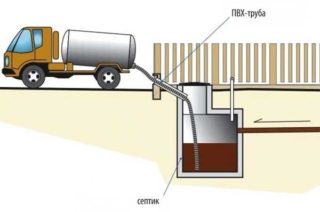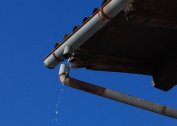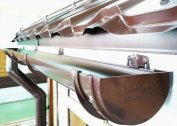A cesspool in a private house is a necessary element of comfort, but you need to approach its arrangement competently. Errors in choosing a place and design flaws lead to the appearance of an unpleasant smell, which will disturb residents.
Definition and purpose of cesspools
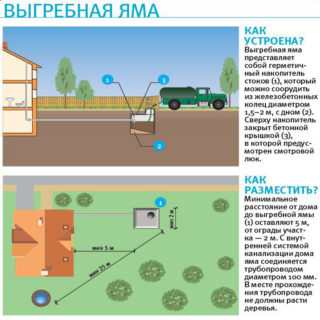 The purpose of the septic tanks is to collect household drains from the toilet, bathroom, and kitchen. In some cases, rainwater is sent there, but it is better not to do this, since with a large accumulation of liquid it can leak to the surface and contaminate the soil. Outdoor summer toilets are made in summer cottages; after filling the pit, they fill it with soil. Waste without access of oxygen under the influence of anaerobic microorganisms is gradually turning into fertilizer for the garden.
The purpose of the septic tanks is to collect household drains from the toilet, bathroom, and kitchen. In some cases, rainwater is sent there, but it is better not to do this, since with a large accumulation of liquid it can leak to the surface and contaminate the soil. Outdoor summer toilets are made in summer cottages; after filling the pit, they fill it with soil. Waste without access of oxygen under the influence of anaerobic microorganisms is gradually turning into fertilizer for the garden.
In private homes, septic tanks are filled with waste from the toilet and water with chemicals for washing dishes, shampoos, gels, acidic products for the kitchen. Such drains must be periodically pumped out and disposed of.
Regulatory requirements
A pit for sewage should be made in accordance with existing sanitary and hygienic standards. There are two reasons for this:
- The safety of the residents themselves. Toxic waste passes through the soil into crops, and with it into the human body, which can cause poisoning or infection.
- If you ignore the requirements, inspection authorities have the right to demand reorganization of the septic tank, which will entail additional costs and expenses.
A cesspool should be located at a distance of more than 10 meters from residential buildings, and at least 25 meters from a source of drinking water. You can not make a septic tank in the lowest place of the site - in the spring it can flood. It is important that a pumping machine can approach the septic tank.
Principle of operation
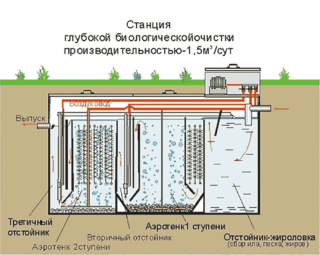 There are several technological solutions for arranging a septic tank. The industry offers plastic containers for storing waste. This is the most hygienic way, since the containers have a bottom and dirty water does not penetrate into the ground. In such containers, solutions of anaerobic bacteria can be poured, which recycle the waste and turn it into fertilizer. This is a non-waste technology.
There are several technological solutions for arranging a septic tank. The industry offers plastic containers for storing waste. This is the most hygienic way, since the containers have a bottom and dirty water does not penetrate into the ground. In such containers, solutions of anaerobic bacteria can be poured, which recycle the waste and turn it into fertilizer. This is a non-waste technology.
There are even more innovative solutions - biological treatment plants for a private home. The output is 98% purified water, which is drained into the street or used for irrigation, and fertilizer for plants is obtained from organic waste.
The simplest solution is to bring the sewer pipes to a septic tank made of concrete rings, periodically ordering a sewer machine. The bottom is both open and airtight.
Dry closets are a good solution for a summer residence and temporary residence, but it is not enough for permanent use, since the device has a small volume and collects waste only from the toilet.
Types of pits and device
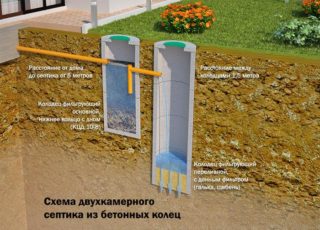 On the site make single-section and two-section septic tanks. The second option allows you to better treat wastewater. For a single-section pit, the bottom is closed so that the waste does not fall into groundwater, and from there into a well or well. In two sections, the first septic tank is closed, the second is open, and the type of soil in the area is taken into account - is it able to quickly absorb liquid.
On the site make single-section and two-section septic tanks. The second option allows you to better treat wastewater. For a single-section pit, the bottom is closed so that the waste does not fall into groundwater, and from there into a well or well. In two sections, the first septic tank is closed, the second is open, and the type of soil in the area is taken into account - is it able to quickly absorb liquid.
Install purchased cast waste storage tanks. They are more expensive and require preliminary preparation, but during operation it is more profitable.
The cesspool is laid out of brick and coated with a concrete mortar from the inside for tightness.The bottom is poured with concrete and reinforced so as not to deform over time. If a cesspool without a bottom is planned, a layer of sand or gravel is poured down.
Most septic tanks are made of concrete rings and sealed with mortar joints. Then cut a hole for supplying a pipe.
Pits made of car tires are an unreliable solution, since rubber loses its properties under the influence of low temperatures, and the liquid seeps into the soil, causing it to silt. This option is considered as a temporary septic tank.
Carrying out the necessary calculations
Before starting work, you need to perform volume calculations, depending on how many people live in the house and how much water is used daily. These indicators affect the depth and width of the pit. Also determine the amount of runoff that absorbs soil per day. It depends on what soil is on the site: if with admixtures of sand, the volume will be larger. Clay practically does not let water through.
Next, markup is carried out on the territory of the house - where the pipe will come from, what slope must be observed for gravity drainage, what distance to the septic tank. It is desirable that the line be direct, then there is no need to additionally equip the inspection wells or put an audit in case of blockages.
Given the results, you can start digging a pit.
Features of the installation of a cesspool for a private house
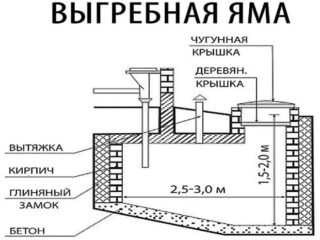 All work is conditionally divided into 5 stages:
All work is conditionally divided into 5 stages:
- preparation of the pit in the ground;
- laying of a plastic container, brick or concrete rings;
- sealing, warming if necessary, if the soil freezes in winter;
- laying pipes from the house to the septic tank;
- verification of work.
To dig a hole, you need the help of an excavator or neighbors with shovels. The width is increased by 20 cm, where subsequently crushed stone or sand will be filled.
For laying concrete rings, a crane is also needed, since it will be difficult to manually put heavy products, in addition there is a risk of dropping and breaking the structure. No equipment is needed for a plastic container; it is put manually. Spread the septic tank out of brick for the longest time and then cover it with mortar.
For insulation, polystyrene sheets are used, which are laid on the outside and strengthen with electrical tape. This material does not leak moisture and does not deteriorate for a long time.
After the pipes are laid and the pit is connected, water is turned on in the house and the liquid is monitored. If everything works, you can fill the trenches with sand and earth. Put a lid on top. The cesspool is ready.
Operation and maintenance
If the cesspool is made correctly, problems with its operation usually do not arise. Regular emptying of the septic tank is required.
You can get rid of the smell with the help of biological agents based on bacteria. In 3-4 days, they process the effluent, and the smell disappears. This is usually done in the warm season, because at low temperatures, microorganisms cannot actively process organics and multiply. There are products on sale that contain bacteria that are resistant to chemicals. They cost more, but they work well and in a short time destroy the stench. Once a year is enough to carry out the procedure.
A cesspool without pumping requires more attention, since siltation of the bottom reduces the rate of absorption of liquid into the soil. After 5–6 years, it may be necessary to dispose of it using a sewer machine.
In two or three-section septic tanks, self-disposal of excess fluid occurs. Solid waste is decomposed using biological products. Subsequently, the processed waste is dug up with soil to restore the nutritional characteristics of the soil.
Advantages and disadvantages of cesspools
If there is no other way to dispose of sewage waste in a summer cottage, a cesspool on the site is only an advantage, but it requires additional costs for pumping.If the septic tank is single-chamber, the waste will need to be removed often.
On a site where it is possible to equip a pit further from the house and the type of soil allows, it is usually built with an open bottom. In this case, the bulk of the waste will be disposed of independently through the soil. Once a year, you will have to pump out solid waste using a machine or a fecal pump with a grinder. In rural areas, special compost heaps are made where the contents are moved for future use. To do this, nitrogen-containing feces are sprinkled with carbon-containing components - straw, sawdust, branches, paper, hay, dry foliage. The decay time is 1.5 years from the moment of laying. The ratio of substances - 1 part of feces, 4 parts of carbon components.
Independent arrangement of the pit will require less cost. Prices for finished cesspools will be higher, but companies provide a guarantee for their work and periodically service them.
